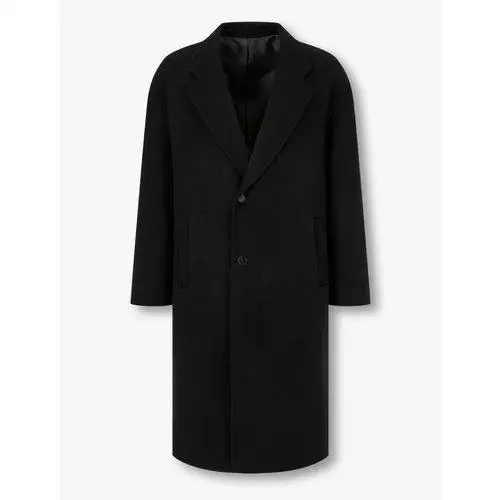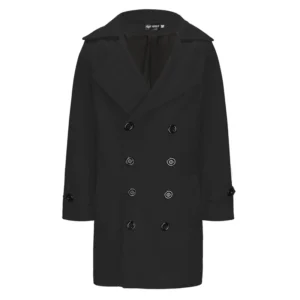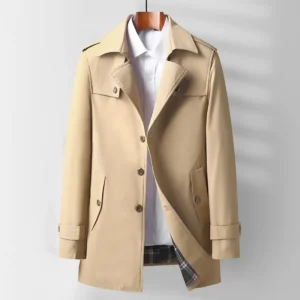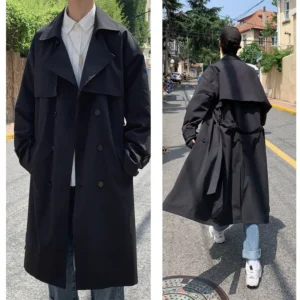Why a Men’s Topcoat is Your Spring Wardrobe Essential
When winter begins to loosen its grip and the first hints of spring appear, the perfect outerwear becomes essential. The spring topcoat stands out as the ideal solution for navigating this tricky seasonal transition. Unlike their heavier winter counterparts, spring topcoat essentials for spring offer lighter construction while maintaining a sophisticated silhouette.
What makes the spring topcoat truly indispensable is its remarkable versatility. Consider these key benefits:
- Weather Adaptability: Provides just enough warmth for chilly mornings while being lightweight enough for warmer afternoons
- Instant Style Elevation: Transforms even the simplest outfits into polished, intentional looks
- Dress Code Flexibility: Seamlessly transitions from formal business settings to casual weekend activities
- Practical Protection: Offers light defense against unexpected spring showers and breezy conditions
The beauty of investing in a quality spring topcoat lies in its longevity and versatility. A well-chosen coat can serve you across multiple seasons and years, making it a smart addition to your wardrobe. Understanding the proper length for spring topcoats enhances both comfort and style as you navigate between winter’s end and summer’s beginning.
The Versatility Factor: From Business to Casual
Few garments can match the spring topcoat’s chameleon-like ability to adapt across different settings. Unlike bulkier winter outerwear that often feels too formal or heavy for casual situations, the spring topcoat effortlessly bridges various dress codes.
This remarkable adaptability means your morning business meeting and evening dinner plans can be served by the same elegant piece. The versatile styling options available with a quality topcoat allow it to complement everything from tailored suits to casual weekend wear. Even a simple t-shirt and jeans combination instantly gains sophistication when topped with a well-fitted spring coat.
Beyond style considerations, a spring topcoat provides practical benefits without the bulk of winter options. It offers just enough protection from light rain and cool breezes while remaining comfortable as temperatures fluctuate throughout the day.
Choosing the Perfect Spring Topcoat: Materials, Colors, and Fit
Making a smart investment in a spring topcoat requires understanding the key elements that distinguish seasonal outerwear. The right combination of material, color, and fit ensures your coat will serve you well throughout the transitional months while complementing your existing wardrobe.
The perfect spring topcoat strikes a balance between lightweight comfort and sufficient protection from unpredictable weather. When selected thoughtfully, it becomes a versatile piece that adapts to both warm sunny days and unexpected cool spells.
Spring-Ready Fabric Selection
The foundation of any great spring topcoat begins with its material. Unlike winter coats that prioritize maximum warmth, spring options focus on versatility and breathability:
Lightweight Wool and Wool Blends: Ideally between 10-12 oz/yd² (300-360 g/m²), these fabrics provide natural temperature regulation while maintaining structure. Lightweight wool blend options offer excellent versatility for spring conditions.
Cotton and Cotton Gabardine: Perfect for drier spring climates, these materials provide breathability with a more casual appearance than wool, making them ideal for weekend wear.
Technical Fabrics: Modern options with water-resistant properties serve well in rainy regions while offering lightweight comfort and easy maintenance.
Wool-Silk-Linen Blends: These premium combinations deliver exceptional breathability with natural temperature regulation and subtle texture interest.
Avoid heavyweight materials like thick melton wool or dense cashmere blends that work better for winter months. These heavier fabrics lack the breathability needed for spring’s fluctuating temperatures and can quickly become uncomfortable as the day warms.
Color Selection for Maximum Versatility
Your spring topcoat’s color significantly impacts its versatility and integration with your existing wardrobe. Strategic color choices enhance wearability across different outfits and occasions:
Classic Neutrals: Camel, navy, and versatile grey options serve as foundational investment colors that coordinate effortlessly with most wardrobes.
Lighter Tones: Stone, light gray, and oatmeal reflect spring’s brighter aesthetic while maintaining versatility across various outfit combinations.
Subtle Colors: Soft sage green, dusty blue, or muted burgundy add personality without limiting versatility, working especially well as secondary options once you’ve secured a neutral foundation piece.
The most strategic approach is matching your topcoat color to your existing wardrobe palette. For example, if your clothing leans toward blues and grays, a camel or light gray coat creates pleasing contrast while remaining compatible with most outfits.
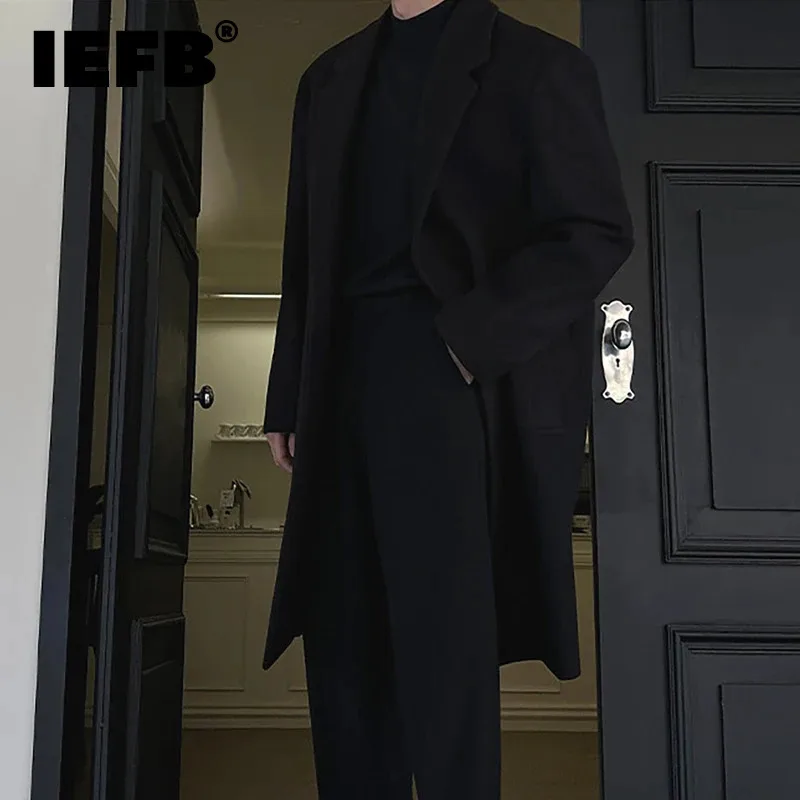
Perfecting the Fit: Spring Layering Considerations
A properly fitted spring topcoat accommodates light layering while maintaining a clean silhouette. Unlike winter coats designed for bulky sweaters underneath, spring topcoats should offer a more refined fit:
Shoulder Alignment: The coat’s shoulder seam should align with or slightly extend beyond your natural shoulder, allowing movement without excess fabric.
Sleeve Length: Ideally ending at the wrist bone or slightly longer, allowing shirt cuffs to show about ¼ to ½ inch when arms are relaxed.
Body Proportion: The chest and waist should allow approximately 1-inch of room over a light jacket or sweater without appearing baggy or constraining movement.
Optimal Length: For maximum versatility, choose a proper fit based on height that typically falls somewhere between mid-thigh and just above the knee.
Common fit mistakes include sleeves that are too long (covering the hands), excessive shoulder width creating a sloppy appearance, or a length that’s either too short (appearing truncated) or too long (overwhelming smaller frames).
Essential Spring Topcoat Styles and Models
Spring topcoat styles range from classic to contemporary, each offering unique advantages. Understanding these different models helps you select one that best matches your personal style and wardrobe needs.
The Single-Breasted Classic
The single-breasted topcoat represents the most versatile option for spring wear. With its clean lines and uncomplicated front closure, this style transitions seamlessly between formal and casual contexts. Modern versions typically feature notch lapels of moderate width (approximately 3-3.5 inches) and a two or three-button front closure positioned to create a flattering V-shape.
This adaptable style excels in virtually any setting—from complementing business suits to elevating weekend casual wear. The simplicity of the single-breasted design makes it particularly accessible for those comparing topcoat styling options against other spring outerwear choices like lightweight blazers.
The Statement Double-Breasted
For those seeking a more distinctive silhouette, the double-breasted styling options offer increased presence and slightly more warmth. The overlapping front panels and typically 4-6 button configuration create a bold chest appearance that naturally draws attention.
Modern interpretations feature slimmer cuts than their traditional counterparts, with narrower lapels and a slightly shorter length to avoid an overly formal or dated appearance. This style particularly excels in business and evening contexts, though contemporary versions can be styled more casually with the right accompanying pieces.
While slightly less versatile than single-breasted options, the double-breasted topcoat makes a sophisticated statement that stands out in professional environments and formal occasions.
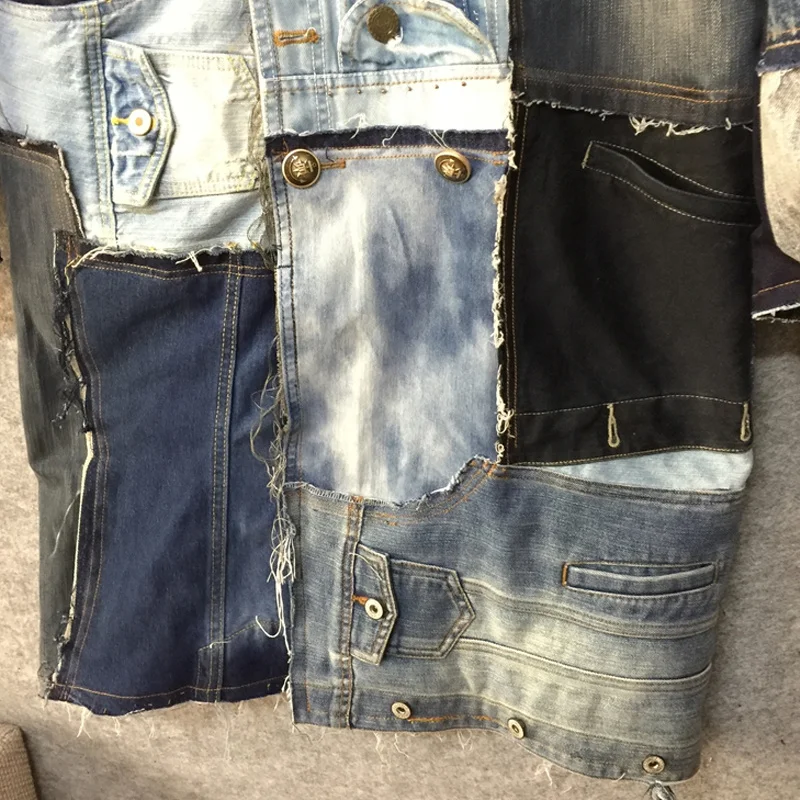
The Raglan Sleeve Option
The raglan sleeve topcoat offers distinct advantages for spring wear, particularly in terms of comfort and ease of movement. Rather than traditional set-in sleeves with shoulder seams, raglan sleeves extend in one piece from the collar to the underarm, creating a more relaxed shoulder structure.
This construction allows for easier layering without restriction and provides superior range of motion—ideal for active city commuting or travel. While slightly more casual in appearance than precise shoulder-seamed alternatives, modern raglan designs maintain a refined aesthetic suitable for business-casual environments.
The raglan style particularly excels in weekend settings and travel scenarios where comfort and movement freedom take priority without sacrificing style.
Mastering Spring Topcoat Outfits: From Office to Weekend
Creating successful spring topcoat outfits requires understanding how to balance proportions, coordinate colors, and adapt to different dress codes. The following combinations provide practical templates for various contexts, allowing you to maximize your topcoat’s versatility.
Business and Formal Styling
When integrating your topcoat into business and formal ensembles, focus on creating a cohesive silhouette with complementary colors:
Classic Suiting Combination: A navy topcoat over a light gray suit creates elegant contrast, while maintaining harmony. Complete with a white or pale blue shirt and burgundy or navy tie.
Monochromatic Mastery: Pair a charcoal topcoat with a slightly lighter gray suit for a sophisticated tonal look. Add subtle pattern through your tie and pocket square for visual interest.
Color Coordination Rule: Your formal styling options work best when the topcoat is either darker than or the same depth as your suit, creating visual balance.
Formal Accessories: Choose leather dress shoes in oxfords or derbies that complement your suit color. A simple pocket square and leather gloves in coordinating tones complete the refined look.
Smart-Casual Mastery
The topcoat truly shines in smart-casual settings, where it elevates more relaxed pieces to create polished ensembles:
Business-Casual Elevation: Pair a camel topcoat with navy chinos, a light blue oxford cloth button-down, and brown suede loafers for a perfectly balanced smart-casual look.
Textural Interest: Combine a gray herringbone topcoat with a fine-gauge merino sweater, white shirt, and dark jeans for a sophisticated yet approachable appearance.
Pattern Mixing: A solid topcoat provides the perfect canvas for introducing subtle pattern mixing underneath, such as a check shirt with a textured knit tie or sweater.
Balanced Formality: Ensure at least two elements of your outfit (such as shoes and trousers) maintain some formality to avoid making the topcoat feel out of place.
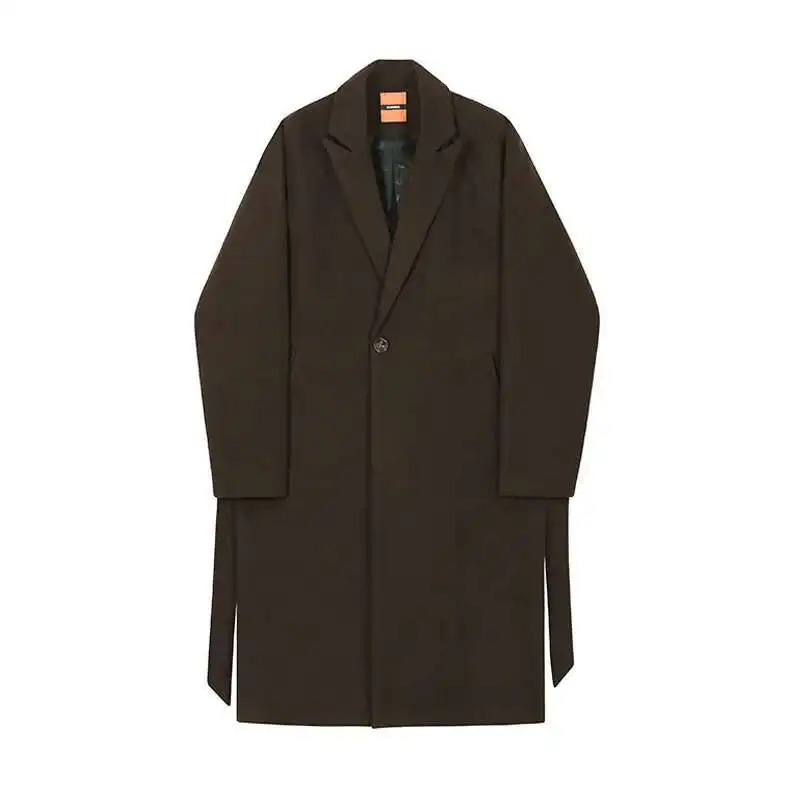
Weekend and Casual Styling
Contrary to common perception, topcoats excel in casual settings when paired thoughtfully:
Elevated Basics: A gray topcoat transforms a simple white t-shirt, selvedge denim, and white sneakers into an intentional, stylish look rather than just weekend basics.
Athleisure Combination: Create an interesting high-low contrast by pairing a structured topcoat with a hoodie, slim joggers, and clean sneakers—an unexpected yet contemporary approach.
Textural Contrast: Balance the refined finish of a topcoat by incorporating more rugged textures underneath, like heavyweight denim, knit sweaters, or chambray shirts.
Weekend Outing Ready: For casual brunches or gallery visits, combine a topcoat with a crewneck sweater, chinos, and suede chukka boots for effortless layering techniques that remain put-together without feeling stuffy.
The Art of Spring Layering with Topcoats
Spring’s unpredictable temperatures demand strategic layering, and the topcoat serves as the perfect outer component of a well-planned layering system. Effective layering creates not only practical warmth adjustment but also visual depth and interest in your outfits.
The key to successful spring layering is building thin, functional layers that can be added or removed as conditions change. This approach provides adaptability while maintaining a clean silhouette without unnecessary bulk.
When layering with a topcoat, consider the combined thickness of all layers to ensure comfortable movement. Each layer should work both as part of the ensemble and independently if the topcoat needs to be removed indoors.
Essential Layering Pieces
These key mid-layers create the foundation for successful spring topcoat combinations:
Lightweight Knitwear: Fine merino wool sweaters (around 1-1.5mm thick) in crewneck or V-neck styles provide warmth without bulk and work perfectly under topcoats. Quarter-zip options offer additional ventilation flexibility.
Strategic Shirting: Oxford cloth button-downs provide more substance than dress shirts, adding texture while remaining comfortable. Poplin or twill shirts offer smoother alternatives that slide easily under additional layers.
Unexpected Mid-Layers: Consider lightweight quilted vests, thin cardigans, or even denim jackets (under longer topcoats) as interesting middle layers that add both warmth and style dimension.
Base Layer Considerations: Choose t-shirts and undershirts in breathable fabrics like pima cotton or modal blends that regulate temperature and wick moisture when layering becomes necessary.
The versatility of these combinations allows you to adapt to temperature changes throughout the day while maintaining a cohesive look that works with your topcoat’s structured silhouette.
Accessorizing Your Spring Topcoat
The right accessories not only enhance your topcoat’s functionality in fluctuating spring conditions but also create distinctive personal style. Thoughtful accessorizing transforms basic topcoat ensembles into memorable, cohesive looks.
Scarves and Neckwear
Lightweight scarves provide both practical warmth and visual interest for spring topcoat outfits:
Seasonal Materials: Opt for cotton, linen, modal blends, or lightweight wool/silk combinations that provide adjustable warmth without bulk.
Strategic Draping: For business contexts, the classic rectangle fold draped evenly on both sides creates a refined look. For casual settings, a loose once-around wrap or simple drape adds effortless style.
Color Coordination: Choose scarves that either complement your coat (analogous colors) for subtle sophistication or provide thoughtful contrast (complementary colors) for visual interest.
A patterned scarf against a solid topcoat adds personality without overwhelming the clean lines of your outerwear.
Footwear Pairings
Your choice of footwear significantly impacts the overall balance of your topcoat ensemble:
Formal Settings: Leather oxfords, cap-toes, or whole-cut shoes in black or dark brown ground business topcoat outfits with appropriate formality.
Smart-Casual Contexts: Suede or leather loafers, chelsea boots, and refined derby shoes create perfect middle-ground options that work across various settings.
Weekend Casual: Clean white leather sneakers, suede chukka boots, or minimal design casual shoes balance the topcoat’s structure with appropriate informality.
The relationship between coat length affects footwear pairings significantly—longer coats generally require more substantial footwear to maintain proportion, while shorter topcoats offer more flexibility with lighter shoe options.
Transitioning Your Topcoat Through Changing Spring Weather
As spring progresses from chilly early days to warmer late-season temperatures, adapting how you wear your topcoat ensures maximum versatility throughout the season.
Early Spring Strategies (40-55°F / 4-13°C)
During the cooler early spring period, focus on these approaches:
Strategic Midlayers: Incorporate lightweight merino sweaters or thin cashmere knits under your topcoat while maintaining a clean line.
Practical Accessories: Light gloves in leather or knit materials and cashmere-blend scarves provide crucial warmth for exposed areas without overwhelming the spring aesthetic.
Color Balance: Even in colder conditions, incorporate one lighter color element (shirt, scarf, or sweater) to reflect the spring transition rather than continuing with all-dark winter tones.
Closed Styling: Wear your topcoat fully buttoned with a scarf to maximize warmth during this transitional period, creating a more formal silhouette as an added benefit.
Late Spring Adaptation (55-70°F / 13-21°C)
As temperatures rise further into the season, modify your approach:
Open-Front Styling: Wear your topcoat unbuttoned over light layers like dress shirts or thin cotton sweaters, creating a more relaxed appearance while extending the coat’s seasonal wearability.
Strategic Shorts: Skip the middle layer entirely when appropriate, wearing the topcoat directly over a shirt for maximum breathability.
Lighter Color Combinations: Transition to lighter-colored shirts and trousers that reflect the warmer season, even if your topcoat is in a darker neutral tone.
Minimal Accessories: Eliminate scarves and gloves, focusing instead on lighter accessories like pocket squares or sunglasses that enhance style without adding warmth.
Mens Double Breasted Pea Coat, Mens Wool Blend Coat, Mens Wool Pea Coat
Price range: $136.84 through $157.36 Select options This product has multiple variants. The options may be chosen on the product pageMens Cashmere Overcoat, Mens Hooded Winter Coat, Mens Wool Blend Coat
Price range: $128.72 through $139.68 Select options This product has multiple variants. The options may be chosen on the product pageMens Grey Overcoat, Mens Wool Blend Coat, Mens Wool Overcoat
$201.28 Select options This product has multiple variants. The options may be chosen on the product pageMens Long Overcoat, Mens Topcoats
Price range: $189.40 through $196.88 Select options This product has multiple variants. The options may be chosen on the product pageMens Dress Coat, Mens Long Overcoat
$76.76 Select options This product has multiple variants. The options may be chosen on the product pageMens Double Breasted Overcoat, Mens Long Overcoat
Price range: $181.32 through $198.08 Select options This product has multiple variants. The options may be chosen on the product page
Caring for Your Spring Topcoat Investment
A quality spring topcoat represents a significant investment that, with proper care, will provide years of stylish service. Appropriate maintenance preserves both appearance and functionality throughout multiple seasons.
Unlike heavy winter coats that typically require professional cleaning only once per season, spring topcoats often need more frequent attention due to increased wear during variable weather conditions. Follow these care guidelines to extend your coat’s lifespan:
Regular Brushing: Use a soft clothes brush after every few wears to remove surface dust and prevent particle buildup in the fabric.
Spot Cleaning: Address small stains immediately using a clean, damp cloth and mild soap if necessary, blotting rather than rubbing.
Strategic Cleaning: Have wool and wool-blend topcoats professionally dry-cleaned only when visibly soiled, typically 1-2 times per season, as excessive cleaning can damage natural fibers.
Proper Storage: When not in use, store on a quality wooden hanger with sufficient shoulder support to maintain the coat’s structure and shape.
Between-Wears Maintenance
These simple practices between wearings significantly extend your topcoat’s freshness and appearance:
Hanging Technique: Use broad, contoured wooden hangers that support the shoulder structure, allowing at least 24 hours between wearings for natural recovery.
Gentle Refreshing: Steam (not iron) wrinkles using a handheld steamer held several inches from the fabric, or hang in a steamy bathroom to release minor wrinkles.
Brush Maintenance: Use a soft-bristled clothes brush in downward strokes to remove surface dust and debris before it settles into fibers.
Protection Measures: Use lint rollers for quick refreshing, and apply fabric protector spray to new coats (test on an inconspicuous area first) to repel water and stains.
Is a Spring Topcoat Right for Your Style and Climate?
While spring topcoats offer remarkable versatility, they may not be ideal for every person or region. Consider these questions to determine if this investment makes sense for your specific situation:
Does your local spring include temperature fluctuations between 40-65°F (4-18°C)?
Spring topcoats excel in these moderate temperature ranges. If your region jumps directly from winter cold to summer heat, you might have limited wearing opportunities.
Do you frequently transition between indoor and outdoor environments?
The topcoat’s easy-on, easy-off nature makes it ideal for commuters and those moving between different settings throughout the day.
Does your personal style include smart-casual or business attire?
While increasingly versatile with casual wear, topcoats naturally complement more refined wardrobes featuring trousers, button-ups, and structured pieces.
Do you value versatile investment pieces over season-specific items?
The topcoat’s cross-seasonal potential makes it ideal for those who prefer fewer, higher-quality garments with multiple uses.
When to Choose Alternative Outerwear
In some situations, other outerwear options might better serve your needs:
Consistently Rainy Springs: In particularly wet climates, a dedicated waterproof trench coat or mac might provide better practical protection.
Extremely Casual Wardrobes: If your daily attire consists exclusively of t-shirts, hoodies and jeans, a more casual style like a harrington jacket or lightweight bomber might integrate more naturally.
Very Warm Spring Climates: Regions that quickly warm to above 70°F (21°C) might benefit more from ultra-lightweight options like unstructured linen-blend blazers or shirt-jackets.
Highly Active Lifestyles: Those who bicycle commute or engage in significant outdoor activity might find technical performance jackets more suitable for their daily needs.
The spring topcoat represents a versatile investment for most men, but understanding your specific needs ensures you’ll make the right outerwear choice for your lifestyle and environment.

